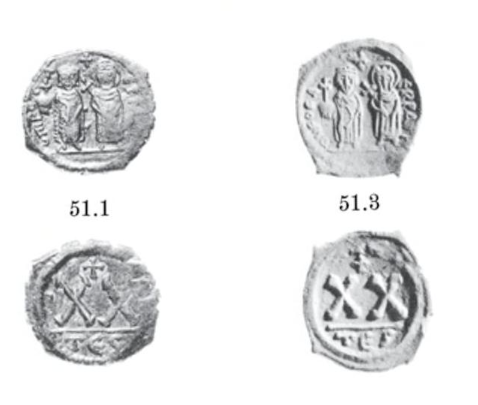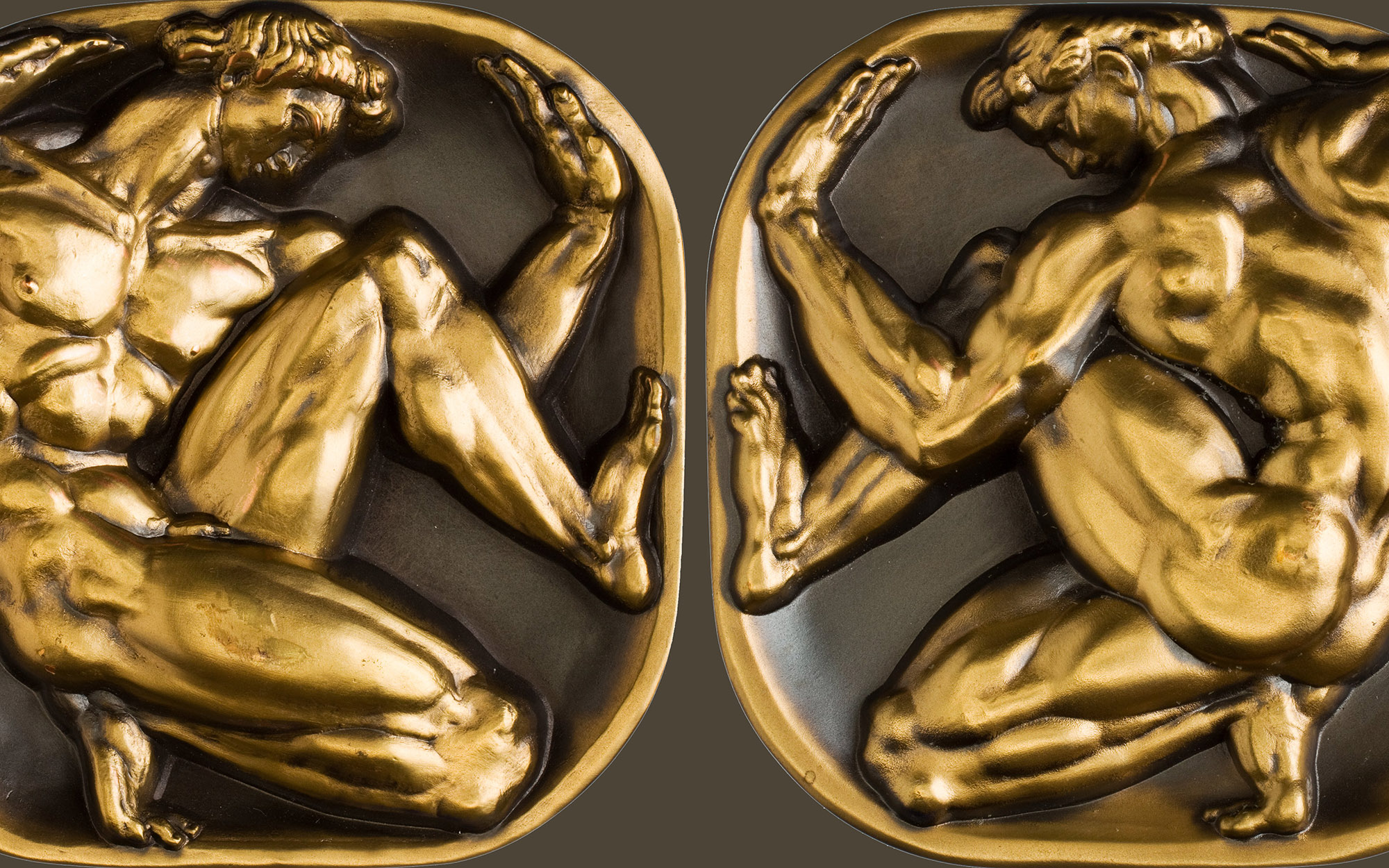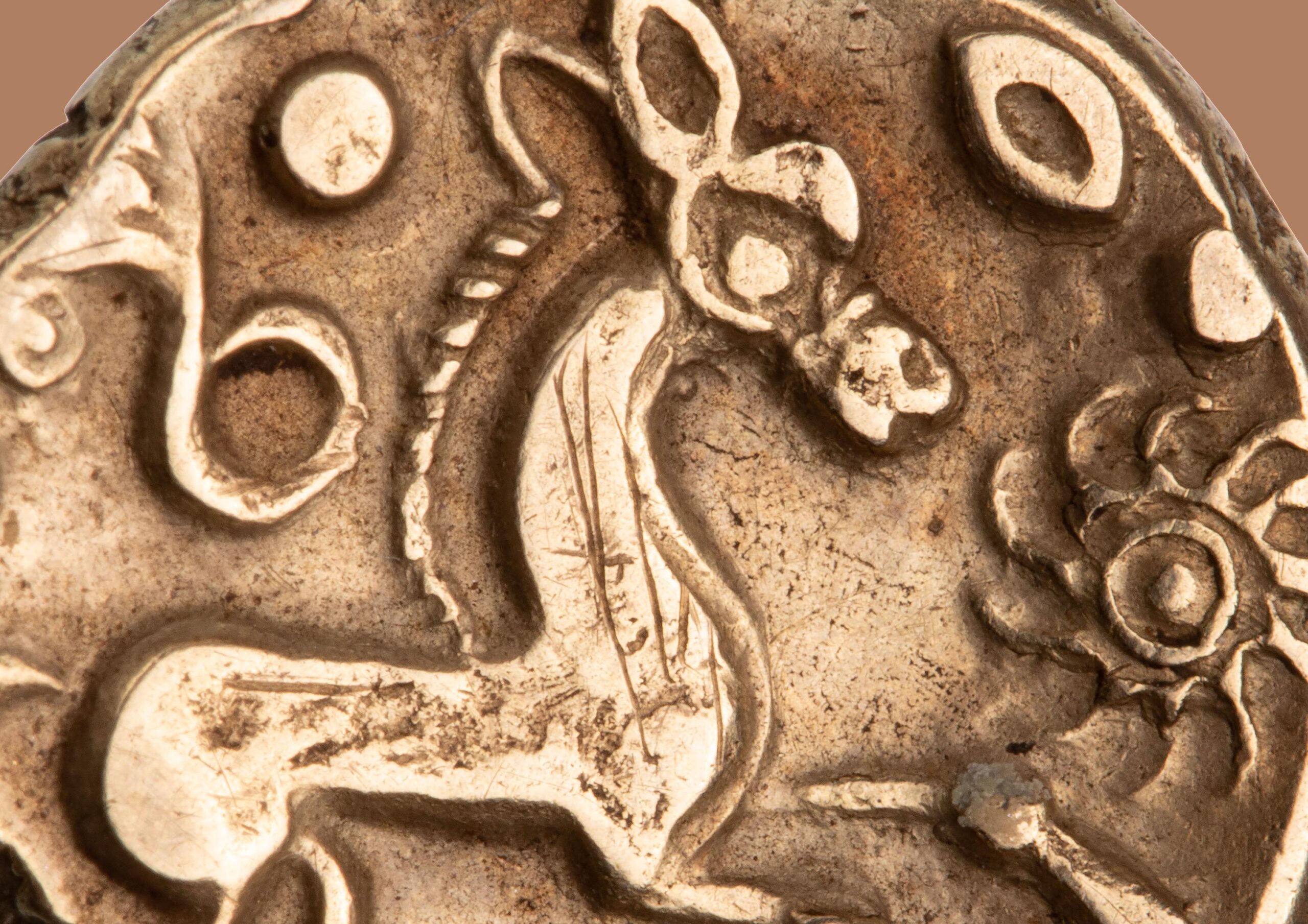The Female Icon During the Reign of Phocas the Thracian
Today’s post comes from Sonia Suben, a third-year student studying anthropology, Classics, and art history at Kenyon College in Gambier, Ohio. She was born and raised in New York City and now resides in Mamaroneck, New York. Sonia’s research focus is Byzantine coinage of the late 6th and early 7th centuries, particularly that of the emperor Phocas the Thracian. This summer, she has been working as an intern assisting in the creation of a digital typology of the Byzantine coins found in the MIBEC and DOC catalogs, as well as unique types found in the ANS’ collection. Beginning in September 2023, Sonia will be studying early Medieval archaeology at University College Cork in Cork, Ireland.
Phocas the Thracian is a figure of the 7th century whose reputation precedes him. Thousands of years later, written records and reference materials regard him as one of the most odious politicians in Byzantine history. His portrait is one of a violent, rash, and misdirected ruler who usurped the throne in an act so violent as to be called sadistic. Despite, or perhaps because of, this legacy, coinage minted under the issue of Phocas served a crucial purpose in political messaging. Coins became a means by which Phocas attempted to legitimize his power in light of his atrocities; these included the slaughter of his predecessor Maurice and the subsequent public mounting of his head on a pike, as well as the slaughter of Maurice’s family. Iconographic elements on coinage were an integral aspect in the attempt to revise the public’s perception of Phocas. In an unprecedented move, Phocas’ empress, Leontia, became an icon of the empire’s former stability amongst Byzantine society. This was most likely meant as an ode to the empire’s past, rather than an indication of personal merit. As such, Leontia’s presence on Byzantine coppers marks a change in the tradition of Byzantine coinage in which the woman of the Empire was featured as a figurehead of stability, even with her ambiguous background.

20 nummia of Phocas depicting the imperial couple. 603–605 CE. DOC 51.
Many of Phocas’ coins were a typical issue of the common imperial bust, either frontal or in profile from the right. A few select coins depict the imperial couple by placing Empress Leontia frontal beside Phocas on the obverse (see images above). Such coins were minted at Constantinople, Cyzicus, Antioch, and Thessalonica. The first female to appear on Byzantine coinage alongside her husband was Sophia, empress of Justin II. Thus, the inclusion of a woman on imperial coinage was still considered radical during Phocas’ brief reign, as it first occurred during the reign of Justin II only 50 years prior. This seemingly sudden appearance of a woman’s portrait on coinage in 565 was concurrent with a cultural perception of the empress that was distinct from previous ones. The common opinion became that Sophia ruled as her husband’s equal, as she took over some of his most important duties after his incapacitation by a vague madness in 574. Art contemporary with the reign of Justin II and Sophia immortalizes her influential role within religious spheres, the control of political scandal, and the immensely important selection of Tiberius II as the subsequent Caesar. As a result, she is known for, “being dominant both during her husband’s lifetime and after his death,” and thus earned her unprecedented position on coinage by merit.
In contrast, Leontia’s memorialization upon coins does not seem to be the result of any ascertainable political involvement or legacy. Context and description for Leontia is lacking to such a great extent that it is quite difficult to source ancient material that mentions her as a member of Phocas’ imperial court at all. When she does appear in texts of the early 7th century, Leontia is mentioned only in passing as Phocas’ wife and the mother of his child. Mentions of her in chronicles of Byzantine history written by Theophanes the Confessor extend only to the point of describing her coronation, and cease after the occurrence of her daughter Domentzia’s wedding in 606 CE. The date and circumstances of her death are unknown, and while it is assumed that it was a result of Phocas’ well-documented violent overthrow, which did not occur until 610 CE, there is no primary source available to verify this. Yet despite the seemingly unremarkable and mundane nature of her life, Leontia was still the second woman ever to be placed on Byzantine coinage. The radical inclusion of Leontia’s figure is supported by the fact that coinage of the imperial couple did not circulate widely during the reigns of either Tiberius or Maurice, who ruled before Phocas usurped the throne.

ÉTIENNE-BARTHÉLEMY GARNIER. The Emperor Maurice dethroned by the usurper
Phocas is put to death by the lictors after witnessing the murder of his five sons. 1790. Musée des Beaux-Arts de Quimper 87-3-2-94.
This begs the question: Why was Leontia’s portrait included alongside Phocas on a significant number of issues in relatively wide circulation? It was certainly not to memorialize or honor her contributions to the empire, the reason for establishing the practice in the case of Empress Sophia; Leontia’s political involvement was nonexistent, and Phocas’ presence so destructive that there was no merit of any sort attributed to it. As the two empresses do not reside in the same niche of historical memory, it is interesting to compare the iconography of Sophia and Leontia on their respective Byzantine coins. The answer to the questions raised by Leontia’s presence lies in the similarities between the images of the two women, rather than their actual lives. As a result, it seems likely that the imperial portraits of Phocas’ issue were used to mimic and evoke the perception of Justin and Sophia’s more respected empire. Coins of the imperial couple intended to raise support and confidence for Phocas’ empire from within the Byzantine population after these plummeted as a result of Phocas’ ascension.
The imperial costume and insignia have been analyzed to a great extent when worn by the emperor. Much less literature exists regarding the bearing of the same symbols by the empress. Even as it became more common, the presence of an empress upon coinage into the year 629, “are always meaningful, and they often appear at points of fracture and transition”. The utility of the image of the empress has a positive correlation with issues of political and social stability. Coins in the later sixth and early seventh century, in which the exact identity of the empress is unclear, evoke a maternal protection of the republic during times of imperial fragility. In the case of an identifiable figure, that same protection is relegated to a child, evoking similar feelings of the woman protecting the health of the empire through the provision of an heir. While this fact gives important insight into why Leontia’s image may have been politically useful, it also further supports the theory that the ability to recognize her as an individual was important to Phocas’ administration: “On the Phokas/Leontia coins, the augusta was, once again, used to reinforce imperial authority and dynastic pretensions” (586). Despite her practical lack of political action or provision of a male heir, this gestures towards the importance of the empress in preserving dynastic succession. This would imply that Phocas’ reign would persist the same as those of his predecessors despite public opposition, rendering the practice futile. However, the use of the empress as a symbol of political value may be even more pointed in the case of Leontia specifically.
When the imperial couple appears on coins issued either by Justin II or Phocas, the image tends to be on the obverse of copper small change, which includes follisses and their divisions. These would have circulated amongst the general Byzantine population, unlike coins made of precious metal, increasing the influence and presence of their message amongst civilians. Additionally, just like their husbands, the empresses both always appear in full imperial dress, and holding imperial insignia reserved for those of highest political and spiritual position. The dress is as follows: Sophia and Leontia are always crowned and almost always nimbate (haloed), indicating their proximity to the church and conveying both heavenly and secular power. Their crowns are often adorned with pendilia, pearls on wires that hang from the crown on either side of the head, an accessory often worn by Byzantine royalty. Throughout the 7th century, the ornaments are more common on the crowns of empresses than emperors, and typically longer when worn by the empress. Their presence in portraits of both women creates a typology of the powerful Byzantine woman that was upheld by the use of similar iconography in both cases. The crown of Leontia on coinage is at times even more elaborate than that of Sophia, including additional triangular or spiked ornaments, as if to emphasize the decoration that identified her as an empress. Otherwise, there is minimal difference between the decoration of the two women, but the significance of the costuming in each case remains.

Mosaic of Justinian and his court (reproduction), dressed in typical imperial garments
depicted on nummi of Justin II. Early 20th century (original 6th century). Metropolitan Museum 25.100.1a-e.
Sophia represents a major deviation from the empress’ typical status; she earned this divine standing, and the affiliated clothing, through her unprecedented role in the actions of the Orthodox Church, carrying out its various sacred rites and administrative duties. As mentioned previously, after the incapacitation of Justin II, Sophia took over the duties of religious administration that were formerly his. She was given complementary prayers alongside her husband, and the church constructed in her name was hailed as an extension of her heavenly beauty. She was also the commander of the Monophysite persecution, ordering conversion to orthodoxy with an alternative of torture or exile. This show of power exemplifies Sophia’s consolidation of the imperial religious duties with their political significance, something only ever managed by the emperor previous to her ascension.

40 nummia of Justin II depicting the imperial couple enthroned. 571–572 CE. DOC 150, 152.
Affiliating these early Christian emblems of power with the empress is representative of a distinct divine status given to Sophia along amongst women. Sophia was more than just the first empress to be placed on Byzantine coinage; she was also the first to take on the authority of the Virgin in the same manner in which the emperor adopted the authority attributed to Jesus. When worn by the emperor, the sacred costume served to transform him into God’s human manifestation, as it, “symbolically [included] the attributes of the anointed and elect one: the divine power, the authority to rule the world, the right to be worshipped”. Conversely, an empress, including the unremarkable Leontia, was not typically believed to have been appointed directly by the will of God. Rather, art historians describe the empress’ relationship to God as one in which the emperor acts as an intermediary: “The empress did not receive her authority from God, but from the emperor” who would crown her after the legal establishment of his own authority” (Brubaker and Tobler 2000, p. 575).

Byzantine silver cross. 500–700 CE. Metropolitan Museum 55.64.3.
Understanding this about the sacred costume returns to the question of why Leontia appears in the same dress as Sophia on coinage. Leontia is regarded in retrospect to have been quite unremarkable at the time of the coin’s issue, in light of her husband’s cruel, volatile nature and dangerous reputation. Correspondingly, she did not evoke the image of the Virgin. This strengthens the conclusion that Leontia did not earn her way onto the coinage of Phocas’ empire at all. Sophia’s great alteration of the iconographic tradition on Byzantine coinage was co-opted by Phocas in an attempt to create a sense of command and security. Thus Leontia’s value was that of an iconic object, not an individual person. Instead of representing personal importance pertaining to rulership or religion, she served as an echo of Sophia’s excellence and control of the important administrative duties of the empire. Byzantine small change under the reign of Phocas was to act as a mirror into the past, not a reflection of the present.
References
Brubaker, L., and Tobler, H. 2000. “The Gender of Money: Byzantine Empresses on Coins (324-802).” Gender and History 12/3: 572-594.
Cameron, A. 1975. “The Empress Sophia.” Byzantion 45/1: 5-21.
Galavaris, G. P. 1958. “The Symbolism of the Imperial Costume as Displayed on Byzantine Coins.” Museum Notes (American Numismatic Society) 8: 99-117.
Grierson, P. 1968. Catalogue of the Byzantine Coins in the Dumbarton Oaks Collection and in the Whittemore Collection II: Part One, Phocas and Heraclius (602-641). Washington D.C.
Mango, C., and Scott, R., eds. 1997. The Chronicles of Theophanes Confessor: Byzantine and Near Eastern History, AD 284-813. New York.




